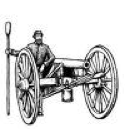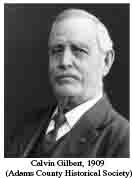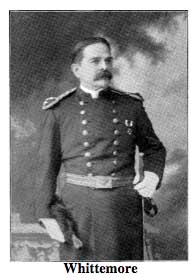
These cannons are much smaller than the other cannons used here in 1863 such as the Parrotts or Napoleons. These weapons are quickly identifiable as the tubes are black, very smooth, and almost always in terrific shape and represented at the time, some pretty serious weapon technology. Their trunnions are sometimes devoid of markings, however some examples have stamps on both trunnions. They always read the same: From the guns perspective, the left trunnion reads Patented Dec. 9, 1862 and the right trunnion reads, Phoenix Iron Co.. Their tubes do not have the breech band seen in the similar looking Parrotts, which distinguishes the two. The 3-inch carriages and limbers are also always equally pristine. This is an 1861 model but manufactured a year later in 1862. I suppose it is possible this cannon saw action here but without the month it was delivered, I cannot know for sure. This model was also mass-produced by the Confederates as well, but not nearly as well made as their Union counterparts. The stamps on the outer muzzles of these rifles are almost always legible and often times pristine which allows tracing back the manufacturing origins a snap. I think this is due to the deep incising of the registry inscription/information along the muzzle as compared to other cannons which were much more shallow in their engraving.
Through my investigations, I learned the man who made the tablets which accompany the cannons also had a hand in restoring these cannons as well. Gettysburg National Military Park has hundreds of these historic artillery pieces on its field of battle. Their carriages, sights, limbers and on rare occasion (should you find them), the caissons have all been restored. Much of the restorative work came from Major Calvin Gilbert who owned the Gettysburg foundry.

Calvin Gilbert owned a Foundry which bore his name in Gettysburg. This man was responsible for creating all of the cast iron battery tablets. His work did not end there as his foundry created many of the carriages for the historic cannons at Gettysburg. Although almost all of the cannons are from the Civil War, their carriages, sights, limbers, wheels and caissons have been restored at his foundry in the early part of the 20th century. Gilbert was in his 70s when he did this work and completed work at other battlefields as well.
The four rifles and the  13th New York Independent Battery Monument (MN057-F) are located on the right or east side of Howard Avenue if traveling northeast. The monument and rifles are 540 feet west of the Biglerville Road intersection. The monument and rifles face and point to the northwest. The monument and rifles are arranged thusly (from left to right): rifle no. 284, rifle no. 252, the monument, rifle no. 217 & rifle no. 575. All the rifles came out of the Phoenix Iron Company foundry. Parking is plentiful and is available road-side at intermittently enlarged shoulder cut-outs, sometimes marked with white striping. Be sure to keep vehicles off the grass or you will be ticketed by park police. I first visited this monument on Tuesday, August 7, 2012 at approximately 5:10 P.M. EDT (532 feet, ASL) and again on July 5, 2012 @ 10:38 A.M. EDT (533 feet ASL). On the second visit, I used a Canon PowerShot 14.1 Megapixel, SX210 IS digital camera for the photos.
13th New York Independent Battery Monument (MN057-F) are located on the right or east side of Howard Avenue if traveling northeast. The monument and rifles are 540 feet west of the Biglerville Road intersection. The monument and rifles face and point to the northwest. The monument and rifles are arranged thusly (from left to right): rifle no. 284, rifle no. 252, the monument, rifle no. 217 & rifle no. 575. All the rifles came out of the Phoenix Iron Company foundry. Parking is plentiful and is available road-side at intermittently enlarged shoulder cut-outs, sometimes marked with white striping. Be sure to keep vehicles off the grass or you will be ticketed by park police. I first visited this monument on Tuesday, August 7, 2012 at approximately 5:10 P.M. EDT (532 feet, ASL) and again on July 5, 2012 @ 10:38 A.M. EDT (533 feet ASL). On the second visit, I used a Canon PowerShot 14.1 Megapixel, SX210 IS digital camera for the photos.
My SOURCE for all things weapons at Gettysburg provided me additional information about this weapon which did not appear on the muzzle. I used red to designate that data. The rest is as it appears exactly on the muzzle, starting at the top or 12 o'clock position and moving clockwise.
No. 217 ......PICo ......1862 ......J.M.W. ......817 ......FDY #228 ......GRVS 7RH
No. 217 refers to the Army registration number, a way for the military to keep track of the guns. PICo refers to the Phoenix Iron Company in Phoenixville, PA, the foundry where the fun was manufactured. I believe when the Rebels were able to capture one of these guns, they copied it and produced their own, although this one was federally made. 1862 refers to the date of manufacture even though this is an 1861 model. 817 lbs refers to the weight of the firing tube. This number is on the bottom of the muzzle. Each gun is usually very unique and has its own weight which distinguishes it from every other gun, like a fingerprint. Many of these rifles are of the same weight (816 lbs) so the foundry must of had some advanced technology to manufacture rifles with such uniformity. J.M.W. are the initials of James Madison Whittemore, the inspector at the Phoenix Iron Company who gave the gun a once over before it was shipped out to the Federal army. FDY #228 is information not found on the muzzle but provided by the website. This is an internal control number specific to the foundry. I believe these are casting numbers. The carriages were approximately 900 pounds which makes this entire weapon over 1,700 pounds. The GRVS 7RH, more information provided by my source, refers to number of rifling grooves, left or right twist. In this case, 7 right hand twists were made to rifle this cannon. If you were to look closely at the close-ups of the muzzle stamps, the rifling grooves are easy to discern.
About the Foundry
The Phoenix Iron Works (1855: Phoenix Iron Company; 1949: Phoenix Iron & Steel Company; 1955: Phoenix Steel Corporation), located in Phoenixville, Pennsylvania, was a significant manufacturer of iron and related products during the 19th century and early 20th century. Phoenix Iron Company was a major producer of cannons for the Union Army during the American Civil War. The company also produced the Phoenix column, a significant advance in construction material. Phoenix Iron Works is a core component of the Phoenixville Historic District, a National Register of Historic Places site and in 2006 was recognized as a Historic Landmark by ASM International. SOURCE & SOURCE
About the Inspector
James Madison Whittemore was born March 5, 1836. Whittemore was a cadet at the Military Academy from July 1, 1855, to July 1, 1860, when he was graduated and was promoted in the Army to Bvt. Second Lieut. of Artillery, July 1, 1860.  He then served in garrison at Ft. Monroe, Va., 1860-61. He was transferred to the Ordnance Corps, May 5, 1861. He served his entire life in the military, eventually commanding the Frankford Arsenal, retiring by Operation of Law, March 5, 1900. (Brigadier-General on Retired List, April 23, 1904) He lived in New Haven, Connecticut upon his retirement. He died, Sept. 6, 1916, at Jamestown, Rhode Island at the age of 80. SOURCE
He then served in garrison at Ft. Monroe, Va., 1860-61. He was transferred to the Ordnance Corps, May 5, 1861. He served his entire life in the military, eventually commanding the Frankford Arsenal, retiring by Operation of Law, March 5, 1900. (Brigadier-General on Retired List, April 23, 1904) He lived in New Haven, Connecticut upon his retirement. He died, Sept. 6, 1916, at Jamestown, Rhode Island at the age of 80. SOURCE
About the Gun
The second most common rifled field artillery in both Armies generally, and the most common on the Maryland Campaign, the 3 inch Ordnance gun was made of hammer-welded, formed, machined iron. It was popular because of its accuracy and reliability, at least those examples built in Federal shops. Less precise machining and lower-grade iron gave their Confederate counterparts more trouble. Those built by the firm of Burton and Archer were know to be problematic. The 3-inch rifle normally fired Hotchkiss or Schenkel shells that weighed between 8 and 9 pounds. In an emergency it could use 10-pounder Parrot ammunition. It could also be used to fire cannister but, as a rifle, was not as effective with this as howitzers or Napoleons. The maximum range of this weapon was 1830 yards, with the barrel/tube Length 69 inches, the bore 3 inches (hence the name) and the total combined weight (already mentioned above), approximately 1720 pounds. Johnson, Curt & Anderson, Richard C., Artillery Hell: Employment of Artillery at Antietam, College Station, TX: Texas A&M University Press, 1995; and
Schwartz, Peter, Artillery at Gettysburg online. SOURCE & SOURCE.
About the Battery
 The 13th New York Independent Battery of Artillery was also known as Baker’s Brigade Artillery. During the battle of Gettysburg, it served as a member of Osborn’s Brigade in the Eleventh Corps, Army of the Potomac. The battery was commanded at Gettysburg by Lieutenant William Wheeler (1836-1864). Under Wheeler's command, the battery brought 118 men to the field serving four Ordnance Rifles, and lost eight wounded and three missing.
The 13th New York Independent Battery of Artillery was also known as Baker’s Brigade Artillery. During the battle of Gettysburg, it served as a member of Osborn’s Brigade in the Eleventh Corps, Army of the Potomac. The battery was commanded at Gettysburg by Lieutenant William Wheeler (1836-1864). Under Wheeler's command, the battery brought 118 men to the field serving four Ordnance Rifles, and lost eight wounded and three missing.
The monument marks the positions of this Battery from July 1 to 3, 1863 and reads as follows:
13th New York
Indpt. Light Battery
(Wheeler's)
Artillery Brigade
11th Corps
———
July 1, 1863. Engaged here. July 2. On Cemetery Hill.
July 3. At repulse of Pickett's Charge
The rifles are mentioned in the NRHP narrative as they and the monuments are contributing structures to the historic district:
Short Physical Description:
Mn, 2 Markers, & 4 cannon. Mn: Smooth base 6'3" square; smooth granite shaft w/incised inscription & bronze medallion on front, bronze reliefs on sides; topped by pyramid.
Flanked by 4 wrought iron 3" ordnance rifled cannon mounted on cast-iron carriages, 2 each side.
Long Physical Description:
Monument that has two flanking markers and four wrought iron three-inch ordnance rifled cannon. Monument is a smooth granite shaft with an incised inscription and bronze medallion on the front, bronze reliefs on the sides, and topped by a pyramidal cap. Base is smooth stone on a 6.3 foot square base. Overall height is 14.8 foot. Flanking markers are one foot square with pyramidal caps. Two cannon are mounted on cast iron carriages on each side of the monument. It is located on West Howard Avenue. NRHP Narrative
Writer's Note:
Before I seriously began to explore Gettysburg and all the subtle nuances which make up the battlefield such as individual registry numbers for artillery pieces, I wrote cursory waymarks, not giving much thought to historical documentation or individual significance of battlefield artifacts and relics. Waymarking in a single area over a period of four years is an evolutionary process. As one begins to learn more about the Civil War, individual battles and all of the little details involved, the quality and usefulness of one's waymarks increase to the point where this author hopes each waymark will be someday useful to someone else as a serious and thorough piece of documentation. To wit, look at the original cr@p I produced less than two years ago for this rifle.